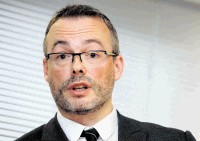
Restrictions on the use of the model of helicopter involved in a ditching incident in the North Sea this week were imposed last night by the Civil Aviation Authority (CAA).
The order from the regulator came as offshore operators said they will resume flights of other Super Puma aircraft today. The EC225 type will remain grounded until further notice, however.
The news followed an announcement earlier in the day from manufacturer Eurocopter that more stringent safety checks would be introduced.
Seventeen passengers and two crew were rescued unharmed after pilots performed an emergency landing during a CHC-operated flight from Aberdeen to an oil rig 86 miles north-west of Shetland.
An initial Air Accident Investigation Branch (AAIB) report into this week’s incident revealed a serious gearbox failure which was similar to the problem which downed another EC225 in May.
Last night, union leaders predicted it would be “weeks” before there was any likelihood of the EC-225 model taking to the skies again. Other types, including the L1 and L2 models, will be brought back into use on a gradual basis starting today. This will help ease some of the backlog which has left hundreds of workers stuck both on and offshore.
Operators, industry leaders, union and regulatory agency representatives on the Helicopter Safety Steering Group (HSSG) met in Aberdeen yesterday to discuss the early findings of the AAIB investigation.
Les Linklater, team leader for Step Change in Safety, said afterwards: “We will be making a phased introduction to some of the fleet that are not affected in terms of the recent ditching.”
Mr Linklater estimated that 40% of the Super Puma fleet would return to service, but “exact numbers” were not available.
He added: “The EC225 aircraft will remain grounded until such time as we are complete in safety assurances and the investigations have taken place.
“We will only be resuming all flights when it is safe to do so.”
RMT union regional organiser Jake Molloy said grounding the EC225 models was the right decision. He said older types are not fitted with the shaft component that has presented problems and so were safe to fly.
He said: “I think until such time as we are confident about the components on the EC225s, we must err on the side of caution.”
Unite union regional industrial officer Willie Wallace added: “Grounding these helicopters is the only sensible and truly safe option available to us until the problem is resolved.”
A CAA spokesman said a note has been issued to operators, informing them of restrictions.
He added: “It doesn’t ban use of the aircraft but details that they shouldn’t be used in certain geographical areas or hostile environments, so very bad weather or visibility for example.”